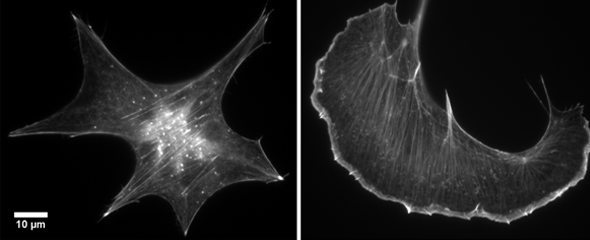Twisted rods made of the protein actin are major constituents in our muscles. These rods, termed actin filaments, are not only crucial to muscle contraction, but also form networks and bundles that contribute to the skeleton of all our body cells. Such filaments stabilise, and mediate shape changes or movements of cells as well as transport processes within them. All these processes are fundamental to life and collectively termed cell motility in research. All multicellular organisms require cell motility to develop and form distinct tissues. Cells of our immune system are highly motile to migrate to sites of infection or into lymph nodes. In addition, cell motility is of highest relevance to cancer, as motility constitutes the fundamental activity acquired by metastasising tumour cells. Scientists working at the Helmholtz Centre for Infection Research and the University of Bordeaux (France) were able to uncover a fundamental mechanism that controls the actin-driven motility of single cells.
In order to migrate in a given direction, cells protrude parts of their surface enveloped by the so-called plasma membrane. These surface projections are known as lamellipodia that are filled with actin filaments and powered by their polymerisation. “In lamellipodia, actin filaments form branched networks,“ Professor Klemens Rottner, scientist at HZI and one of the senior authors of the study explains. “These networks are highly dynamic.“ Actin filaments in such networks assemble and disassemble at high speeds, and growth rates are distinct at the two filament ends. “The rapidly growing filament ends push the plasma membrane, thereby moving the lamellipodium tip forward on the extracellular surface,” Rottner describes.
The lamellipodium tip harbours a plethora of proteins that actively control growth and branching of embedded actin filaments. Klemens Rottner states: “The continuous branching of filaments is essential for maintenance and growth of the actin network.” One of the main activators of branching is known as the WAVE complex, which is attached to the plasma membrane. The researchers in the labs of Grégory Giannone (University of Bordeaux) and Klemens Rottner (HZI) observed individual WAVE complexes using fluorescently tagged complex subunits and superresolution microscopy. They also realised that mechanical forces, exerted onto WAVE complexes by individual actin filaments, reduced complex activities. Rottner explains: “To this end, scientists have traditionally been focussing on the biochemical regulation of signals controlling actin dynamics, whereas the biomechanical aspects of such processes are just beginning to emerge.”
Since his PhD studies, Rottner is interested in the various factors regulating the dynamic assembly and disassembly of actin filaments. To study their respective function, his group at HZI has been employing CRISPR/Cas9-mediated genome editing to build up a collection of cell lines lacking the most relevant ones of these factors. The two co-authors, Dr Frieda Kage and Dr Matthias Schaks, were instrumental for the development of this cell line collection and also generated lines eliminated for individual WAVE complex subunits. One of these WAVE complex-deficient cell lines was equipped with a modified version of a WAVE complex subunit employed as follows. The subunit was engineered to span the plasma membrane and present a green fluorescent protein on the outside surface of the cell.
Rottner’s collaborator Giannone and his staff at the University of Bordeaux then employed small beads harbouring anti-GFP antibodies that can grab onto the membrane-spanning WAVE complexes. Using optical tweezers, they positioned these beads onto cells and held them into place or removed them, thereby measuring the forces required to pull the WAVE complex off the lamellipodium tip. Interestingly, the forces required for WAVE complex removal were in the same range as those previously established to be exerted by individual, growing actin filaments.
Based on their observations, the collaborating groups developed a model for mechanical feedback control of lamellipodia-mediated cell motility: In lamellipodia with slowly growing actin filaments, WAVE complexes accumulate at the lamellipodium tip, accelerating filament branching and network growth. The mechanical forces exerted by the increased number and growth rate of actin filaments in turn reduces WAVE complex activities, thus reducing filament assembly enforcing a new round of WAVE complex accumulation – and so forth (Figure 1). Klemens Rottner states: “Our model for the first time explains a feedback mechanism of lamellipodium protrusion and motility that is based on biomechanical signalling.”
“Detailed analysis of feedback mechanisms is precisely what the actin field needs,” actin dynamics experts Laura Machesky and Robert Insall emphasise in their News & Views-article co-published in Nature Cell Biology with the original research summarised here. Finally, Klemens Rottner is anticipating: “Our approaches of force measurement and cell surface manipulation will also be useful for infection research.” These technologies could facilitate studying interactions of infectious particles such as bacteria or even viruses with host cell surfaces.
Original publication:
Mehidi A, Kage F, Karatas Z, Cercy M, Schaks M, Polesskaya A, Sainlos M, Gautreau AM, Rossier O, Rottner K, Giannone G. Forces generated by lamellipodial actin filament elongation regulate the WAVE complex during cell migration. Nat Cell Biol. 2021 Nov 4. doi: 10.1038/s41556-021-00786-8. Epub ahead of print. PMID: 34737443.
News & Views – article in the same issue:
Machesky LM, Insall RH. WAVE complex regulation by force. Nat Cell Biol. 2021 Nov 4. doi: 10.1038/s41556-021-00790-y. Epub ahead of print. PMID: 34737441.
Author: Dr Ulrike Schneeweiß

